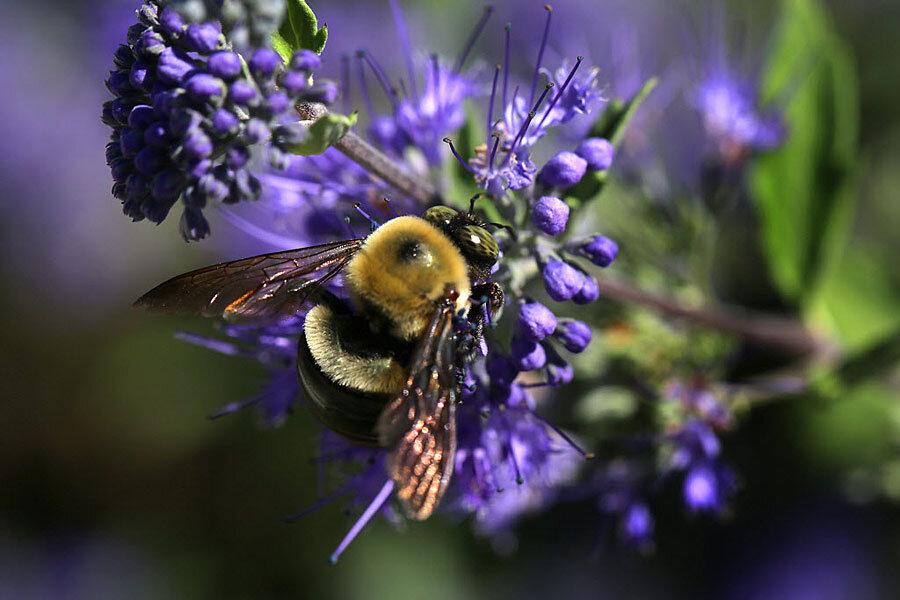Wild bees are in decline. How can we take the sting out of it?
Loading...
Bees are crucial pollinators for crops across the United States, but the buzzing bees are disappearing.
In recent years, scientists and policymakers have been scrambling to determine why commercial honeybee colonies have been collapsing in the phenomenon known as colony collapse disorder. However, recent research suggests that native bee species are equally important to crop pollination but most research had focused on the European honeybee, the non-native species found in commercial hives.
In response to a call for a pollinator assessment from the White House, researchers at the University of Vermont have created the first-ever map of wild bee populations across the country. Their research reveals a significant decline of wild bees across many of the nation's key farming regions, according to a paper published Monday in the journal Proceedings of the National Academy of Sciences. And some 39 percent of farmland containing crops dependent on pollination face a dangerous mismatch: the demand for pollination is rising as the population of wild bees is shrinking.
Although this report may seem like all gloom and doom for the bees, it could help scientists identify ways to save the bees.
“Until this study, we didn’t have a national mapped picture about the status of wild bees and their impacts on pollination,” study lead author Insu Koh, a researcher at the University of Vermont’s Gund Institute for Ecological Economics, said in a news release.
"We can now predict which areas are suffering the biggest declines of wild bee abundance," he said, "and identify those areas, with low bee supply and high bee demand, that are the top priority for conservation."
In 139 counties, wild bee populations are falling as crop pollination demands are rising. And that disastrous combination shows up in some of the key agricultural regions in the US like central California, the corn belt of the Midwest, and the Mississippi River valley, among others.
"It’s clear that pollinators are in trouble," said Taylor Ricketts, the senior author on the new study and director of UVM’s Gund Institute. "But what’s been less clear is where they are in the most trouble – and where their decline will have the most consequence for farms and food."
This map can help scientists and lawmakers better understand those consequences.
"By highlighting regions with loss of habitat for wild bees, government agencies and private organizations can focus their efforts at the national, regional, and state scales to support these important pollinators for more sustainable agricultural and natural landscapes," said Michigan State University’s Rufus Isaacs, one of the co-authors on the study and leader of the Integrated Crop Pollination Project, a USDA-funded effort that supported the new research.
The researchers specifically identify two main policy implications that arise from their research. They call for programs designed to protect the habitat of these wild pollinators, targeting such efforts on the places identified in this paper. They also suggest increased monitoring of wild bee populations to better understand trends in the future and proceed with conservation efforts.
The most significant pollination mismatch is seen around croplands containing those plants that most need the pollinators. Some of those foods include pumpkins, watermelons, pears, peaches, plums, apples, and blueberries.
Wild bees are already shouldering some of the burden left by declining managed honeybee colonies.
"When sufficient habitat exists, wild bees are already contributing the majority of pollination for some crops. Even around managed pollinators, wild bees complement pollination in ways that can increase crop yields," said Neal Williams, a co-author on the study from the University of California, Davis.
According to a memo from the White House, some 40 percent of honeybee colonies were lost last year. The memo also says, "Honey bee pollination alone adds more than $15 billion in value to agricultural crops each year, and helps ensure that our diets include ample fruits, nuts, and vegetables. This tremendously valuable service is provided to society by honey bees, native bees and other insect pollinators, birds, and bats."
Dr. Ricketts said, "Most people can think of one or two types of bee, but there are 4,000 species in the U.S. alone."
"Wild bees are a precious natural resource we should celebrate and protect," he said. "If managed with care, they can help us continue to produce billions of dollars in agricultural income and a wonderful diversity of nutritious food."






